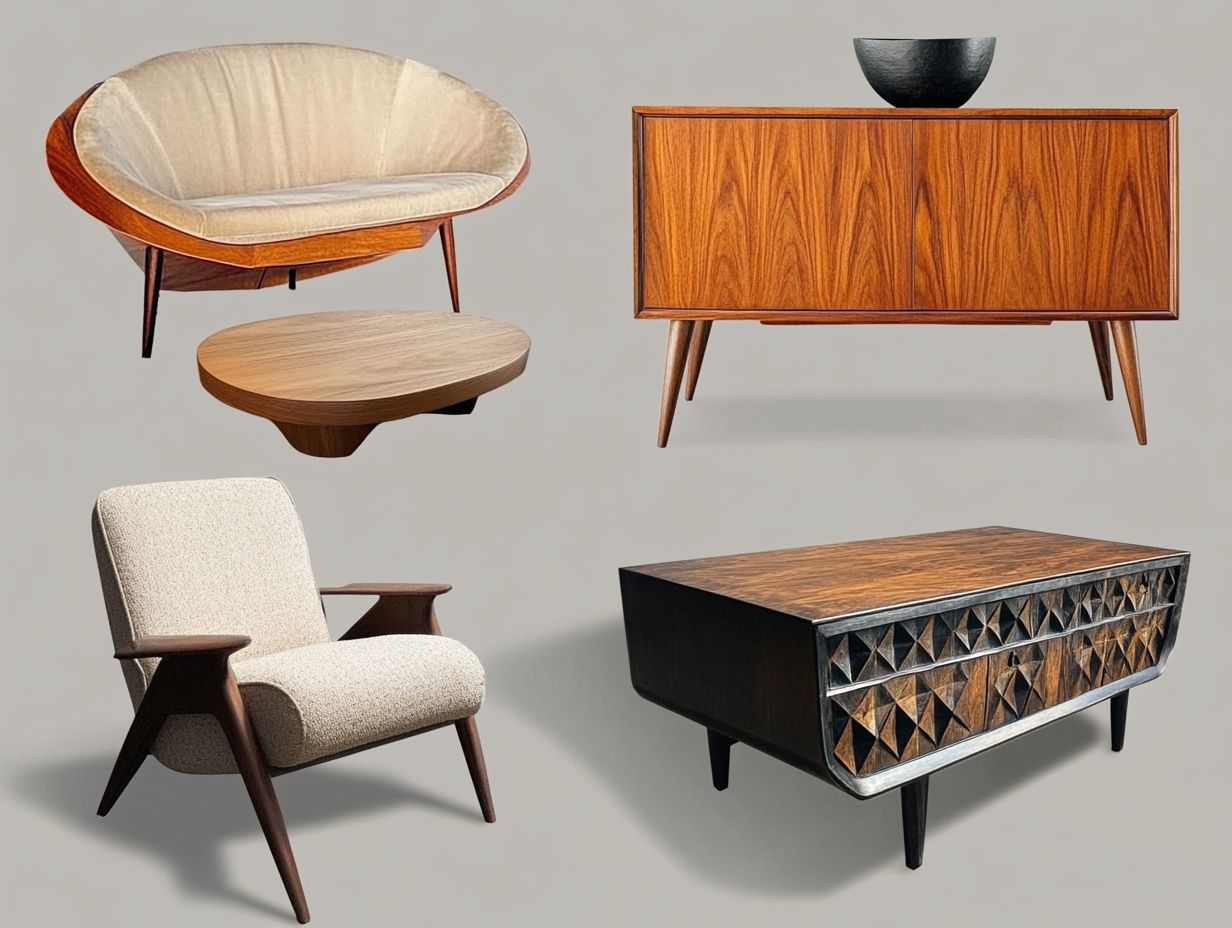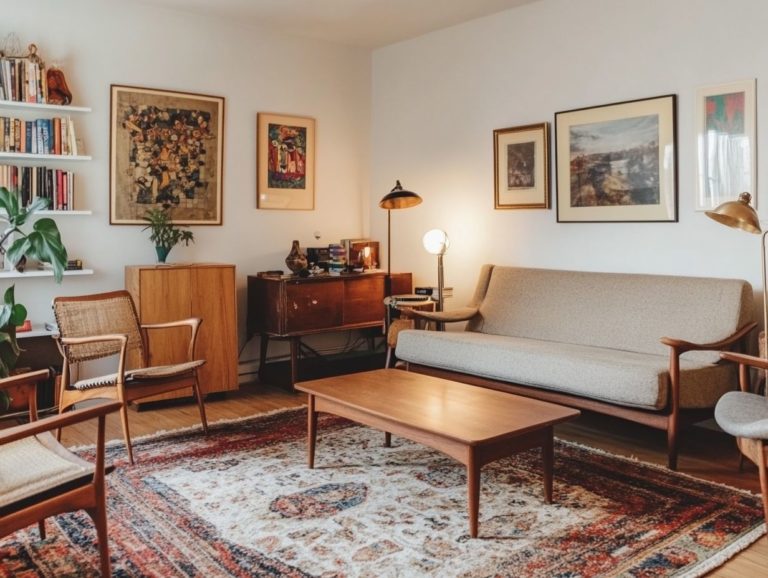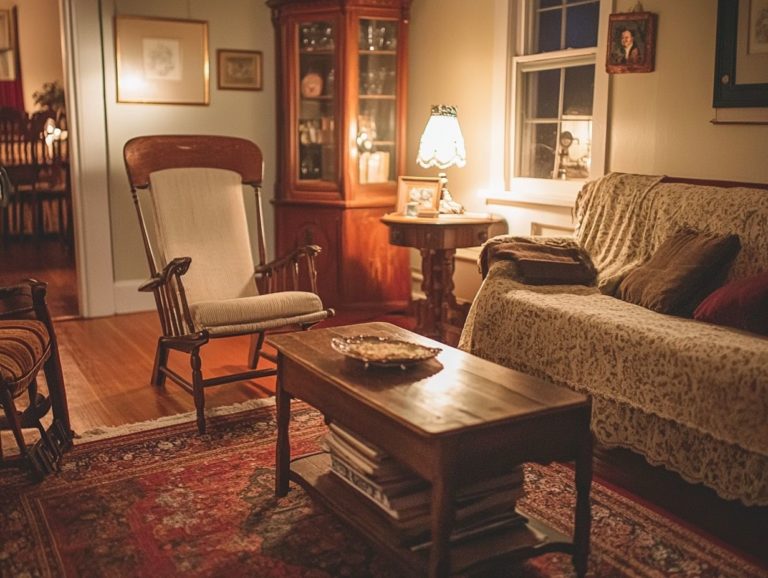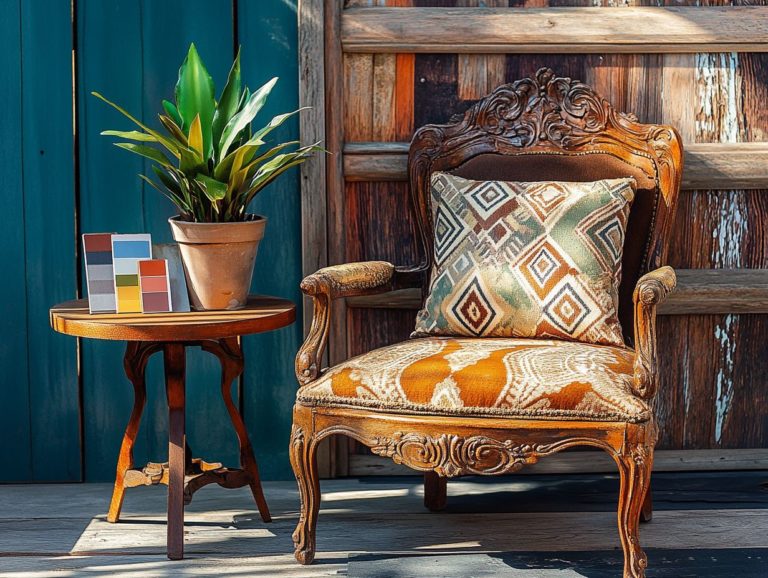Understanding Vintage Furniture Styles by Era
Vintage furniture possesses a distinctive charm and character that can elevate any space into something truly special.
This exploration delves into vintage styles spanning various eras. You will learn to identify authentic vintage pieces and care for them properly.
When it comes to buying and selling vintage furniture, you will gain valuable insights, including tips on where to uncover hidden treasures and how to price them effectively.
Get ready to discover the stunning beauty and unique stories behind vintage furniture! You won t want to miss this!
Contents
- Key Takeaways on Vintage Furniture Styles:
- What is Vintage Furniture?
- Furniture Styles by Era
- Identifying Vintage Furniture
- Caring for Vintage Furniture
- Popular Vintage Furniture Styles and Historical Progression
- Buying and Selling Vintage Furniture and Collecting Antiques
- Frequently Asked Questions
- What is the importance of understanding vintage furniture styles by era?
- What are some popular vintage furniture styles by era, including American design and Victorian Period?
- How can I identify the era of a piece of vintage furniture?
- What are some key characteristics of Art Deco vintage furniture, influenced by eclectic revivalism and social change?
- Are vintage furniture styles by era always accurate?
- Is it important to consider the condition of vintage furniture when studying its style by era?
Key Takeaways on Vintage Furniture Styles:

- Recognize vintage furniture by understanding the time period it was made and its key characteristics.
- Look for defining features and markings when identifying vintage furniture, and learn how to maintain it for longevity.
- Popular vintage furniture styles include Mid-Century Modern, Art Deco, and Victorian, which can be found and priced through various sources.
What is Vintage Furniture?
Vintage furniture, with its rich history and exquisite craftsmanship, often mirrors the social changes and artistic movements that shaped its era. This category includes items that are typically at least 20 years old, showcasing a diverse array of furniture styles, craftsmanship techniques, and materials.
From the intricate details of Louis XIV to the clean lines of Mid-Century Modern, each vintage piece serves as a narrative of its time. They transform from mere functional items into significant cultural artifacts.
These pieces vividly remind us of historical progress, encapsulating the aesthetics and values of their respective periods. For example, the Victorian Period boasted elaborate designs and intricate woodwork, reflecting a time that valued beauty and craftsmanship. In contrast, the sleek forms of Art Deco emerged in the 1920s as a stylish response to industrialization, emphasizing elegance and modernity.
By exploring these varied styles, we can appreciate how vintage furniture enhances the beauty of a space and offers a tangible link to the past, underscoring its importance within the broader realm of antiques and interior design.
Furniture Styles by Era
Furniture styles have undergone a remarkable evolution over the years, serving as a mirror to the cultural, social, and artistic shifts of each era. Starting from the opulent designs of Louis XIV in France, we can trace a fascinating journey through various styles like Rococo, Neoclassical, and Victorian in England.
American design innovations and the sleek aesthetics of Scandinavian furniture followed suit, making their own distinct marks. The Mid-Century Modern and Art Deco movements are prime examples of how furniture design adapts to societal trends while also influencing them, showcasing the dynamic interplay between style and culture.
Exploring Different Furniture Periods
Throughout history, certain periods have birthed unique furniture styles, each with its own flair and character. We can trace this evolution from the opulence of the Louis XIV and R gence periods in France to the intricate details of Rococo and Neoclassical styles, and onward to the functional elegance of Victorian and Federal Period furniture in England and America.
Later, Mid-Century Modern and Art Deco styles emerged, reflecting shifting tastes and innovations in furniture construction that mirror broader societal changes.
As societal norms and economic conditions fluctuated, these designs evolved, often echoing cultural narratives and technological advancements. For instance, the Arts and Crafts movement emphasized craftsmanship in response to the mass production of the Industrial Revolution, advocating for a return to handmade quality and the use of natural materials.
This legacy continues to resonate in modern design, where minimalism and sustainability reign supreme, drawing inspiration from the clean lines and functionality of Mid-Century pieces. The interplay between these diverse periods creates a rich tapestry of design that informs contemporary aesthetics, inviting us to appreciate the stories behind each style.
Key Characteristics and Influences
The key characteristics of antique furniture are defined by exceptional skill in making things, the materials used, and the artistic influences that shaped their design. You ll notice elements like intricate carvings, ornate details, and quality woods that mark styles from the Louis XIV and Victorian periods.
The clean lines of Mid-Century Modern furniture represent a shift toward simplicity and functionality. Understanding these identifying features not only enhances your appreciation for vintage pieces but also helps you recognize a mix of styles in contemporary designs.
Take the Baroque aesthetic, for instance. Its extravagance and dramatic flair stand in stark contrast to the understated elegance of Shaker furniture. This knowledge gives you the power to discern the nuances between styles, providing invaluable context when evaluating pieces.
You’ll find that historical movements inspire current trends, like the comeback of vintage styles in modern minimalism. Being aware of these stylistic roots deepens your understanding of not just the history of furniture design but also its ongoing conversation with contemporary aesthetics.
Identifying Vintage Furniture

Identifying vintage furniture requires a discerning eye for key features and markings that set these distinctive pieces apart from contemporary alternatives. Consider factors like construction methods, materials, and specific design elements that reveal the era and style of a piece, whether it s a Victorian sofa or a Mid-Century Modern chair.
By understanding these distinguishing traits, you can truly appreciate the skill in making things and historical significance in antique furniture. This knowledge gives you the power to navigate a market often saturated with reproductions, making it easier to spot authentic vintage treasures.
Key Features and Markings to Look For
When you re identifying vintage furniture, the key features and markings are essential for establishing both authenticity and value. Seek out signs of craftsmanship, like dovetail joints a type of joint that joins two pieces of wood together securely hand-carved details, and specific materials that reflect a particular period. Think walnut in Victorian pieces or teak in Mid-Century Modern designs.
Labels or stamps from renowned makers, such as Thomas Chippendale or George Hepplewhite, can dramatically enhance a piece s history of ownership and desirability.
Different styles showcase unique characteristics that offer further insights into age and origin. For instance, Art Deco furniture often boasts bold geometric patterns and luxurious materials like chrome and glass. On the other hand, Arts and Crafts pieces typically exhibit an ‘honest’ aesthetic, featuring visible joinery and natural finishes.
It’s also wise to pay close attention to the hardware. Original pulls or knobs can serve as key indicators of authentic designs from specific decorative movements.
Understanding the context of each piece s era allows you to uncover details that might otherwise go unnoticed, making each discovery not just enlightening but truly meaningful.
Caring for Vintage Furniture
Caring for vintage furniture is crucial for ensuring its longevity and preserving its unique historical and artistic value. Proper maintenance requires an understanding of the specific needs of different furniture styles, like the delicate finishes of Rococo pieces or the sturdy construction of Victorian designs.
Regular cleaning, mindful climate control, and careful handling are essential practices that can prevent deterioration and keep these cherished items in excellent condition for generations to come.
Tips for Maintenance and Preservation
Maintaining and preserving vintage furniture requires careful attention to ensure these exquisite pieces retain their charm and integrity over time. Regularly dusting with soft cloths and using suitable cleaning products while steering clear of harsh chemicals are fundamental practices that help maintain the original finishes and prevent damage.
Understanding the construction methods of different periods guides you in applying appropriate repair techniques, allowing you to preserve the historical authenticity of each piece.
It is essential to monitor environmental factors such as humidity and sunlight exposure, which can lead to fading and warping. Employ coasters and placemats to protect surfaces from scratches caused by everyday use.
When faced with common issues like scratches, you can polish them gently with fine-grade sandpaper, followed by a suitable wood finish, to restore the appearance without compromising integrity.
If you are responsible for caring for vintage furniture, don’t miss out on using specialized waxes or restoratives designed for specific woods, as these enhance and protect each piece beautifully.
Keeping an eye on how the wood pieces are connected together is crucial; ignoring these details can lead to more significant problems down the line.
Popular Vintage Furniture Styles and Historical Progression
Popular vintage furniture styles offer a captivating array of designs that reflect distinct historical contexts and aesthetic preferences. From the intricate detailing of Victorian furniture to the sleek minimalism of Scandinavian design, each style unfolds a narrative rich in cultural significance and artistic influence.
The Mid-Century Modern movement, celebrated for its clean lines and functional forms, alongside the striking geometric patterns of Art Deco, showcases the remarkable diversity in vintage furniture. To truly appreciate this exciting mix, it’s important to understand what you should know about vintage furniture styles, which captivates collectors and interior designers alike, inviting you to explore the beauty and stories behind each piece.
Examples and Descriptions

Examples of vintage furniture styles offer a fascinating glimpse into the historical contexts and artistic movements that shaped them. Take Victorian furniture, for example; it is celebrated for its elaborate carvings, rich fabrics, and grandiose presence, often featuring intricate details that narrate a story of opulence.
On the other hand, Mid-Century Modern pieces emphasize functionality and simplicity, boasting sleek lines and innovative materials. Art Deco, with its bold colors and geometric shapes, mirrors the exuberance of the 1920s and 1930s.
As you explore the Victorian era, you might come across ornately designed parlor sets lavishly adorned with plush upholstery and mahogany finishes, serving as the ultimate centerpiece for gatherings. Then, there are Mid-Century Modern chairs, like the iconic Eames Lounge Chair, which are lauded for their ergonomic design and molded plywood construction. To learn more about these styles and others, check out common vintage decor styles explained, effortlessly merging aesthetics with comfort.
Meanwhile, Art Deco furniture often features striking mirrored surfaces and luxurious fabrics. For instance, the exquisite cocktail tables encapsulate the glamour of the Jazz Age, captivating both collectors and enthusiasts with their bold visual statements.
Buying and Selling Vintage Furniture and Collecting Antiques
Engaging in the buying and selling of vintage furniture immerses you in a distinctive market where a deep understanding of antiques and pricing can greatly enhance your experience. As an enthusiast or collector, you need to weigh crucial factors such as condition, rarity, and provenance to assess market value accurately, ensuring that your purchasing and selling decisions are well-informed.
With the emergence of online platforms and vintage markets, the opportunities for discovering unique pieces have multiplied. Therefore, it becomes vital for you to remain informed and connected within this vibrant community.
Where to Find and How to Price
Finding vintage furniture is an exciting adventure. Visit charming antique shops, bustling flea markets, online marketplaces, and thrilling auctions. Pricing those vintage treasures is equally important; understanding market trends the general direction in which the prices of items are moving and the elements that influence value, such as condition, rarity, and demand, will help you secure fair transactions.
Know reputable sellers to enhance your buying and selling journey. This knowledge can make your experience thrilling and rewarding, allowing you to uncover unique items while maximizing your investments.
Start your hunt at local estate sales. You might uncover hidden gems! Thrift stores can also be treasure troves, often filled with quality finds at irresistibly low prices.
Check out online platforms like Etsy and eBay for more vintage options. These sites cater specifically to vintage enthusiasts and enable you to compare options across a wider spectrum. When pricing vintage items, take the time to meticulously assess their physical condition and keep an eye on recent sales of similar pieces. This context will provide invaluable insight into current market demand.
Networking with fellow collectors opens doors to exclusive opportunities, ensuring that every vintage acquisition you make is not only stylish but also a savvy investment.
Frequently Asked Questions
What is the importance of understanding vintage furniture styles by era?
Understanding vintage furniture styles by era allows you to accurately identify and date pieces while gaining insight into the historical and cultural influences that shaped them.
What are some popular vintage furniture styles by era, including American design and Victorian Period?

Some popular vintage furniture styles by era include Art Deco, Mid-Century Modern, Victorian, and Arts and Crafts.
How can I identify the era of a piece of vintage furniture?
You can identify the era of a piece of vintage furniture by examining its design elements, construction methods, and materials used. Researching and comparing with reference materials can also help.
Art Deco vintage furniture is known for its sleek, geometric shapes, bold colors, and luxurious materials such as chrome, glass, and lacquered wood.
Are vintage furniture styles by era always accurate?
While vintage furniture styles by era can provide a general timeline and aesthetic for pieces, it is not always accurate as styles can overlap and change over time. Other factors, such as regional influences and individual designer styles, can also affect the appearance of a piece.
Is it important to consider the condition of vintage furniture when studying its style by era?
Yes, the condition of vintage furniture can provide clues about its age and authenticity. For example, a piece with worn or distressed edges may indicate that it is from an earlier era, while a piece with modern repairs may not be a true representation of its original style by era.
Ready to dive into the world of vintage furniture? Explore unique finds today!






